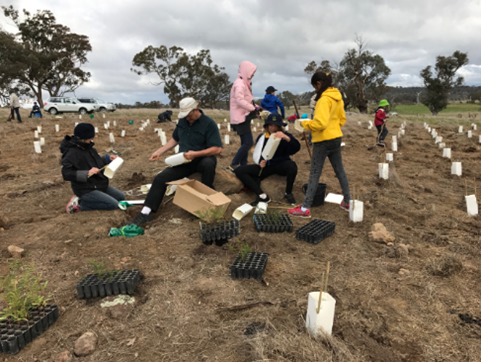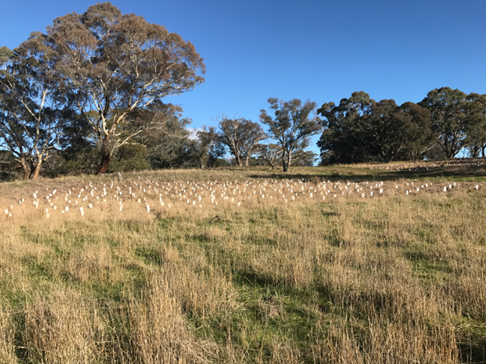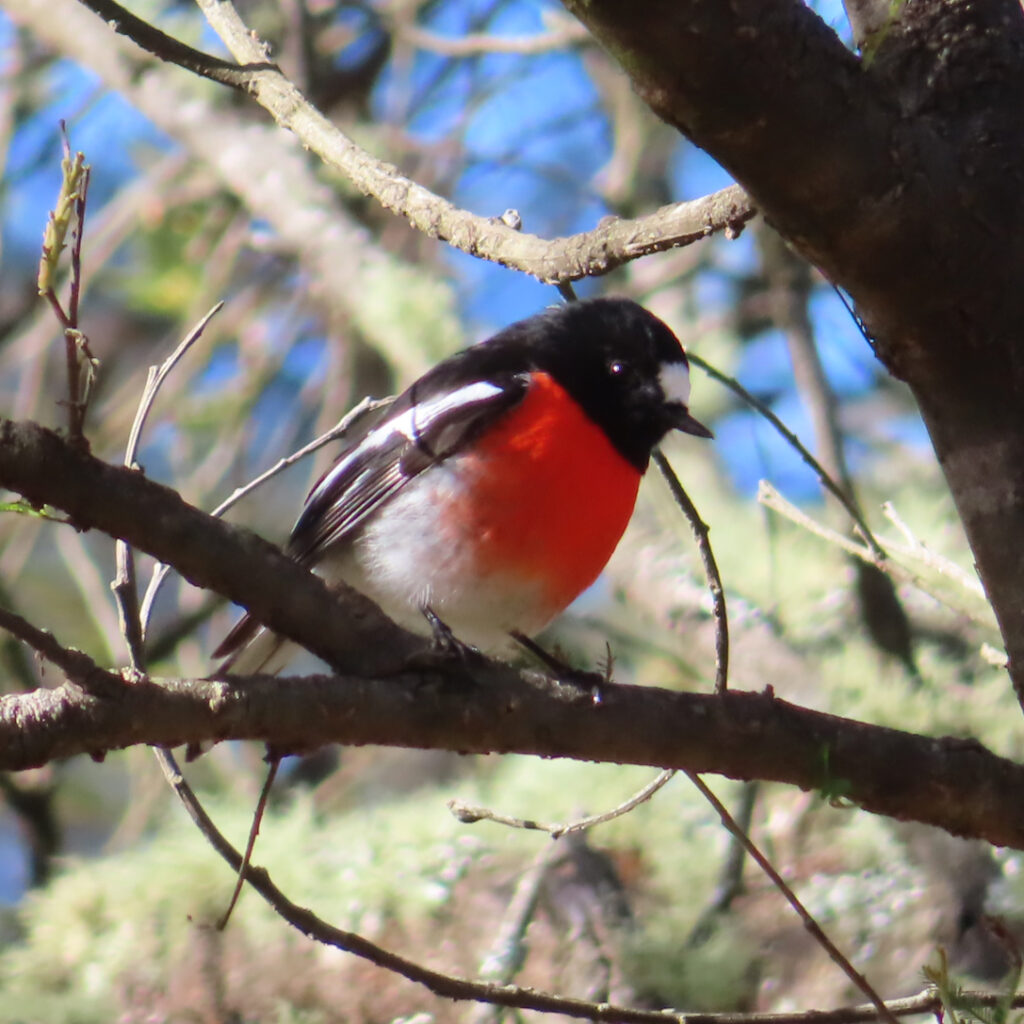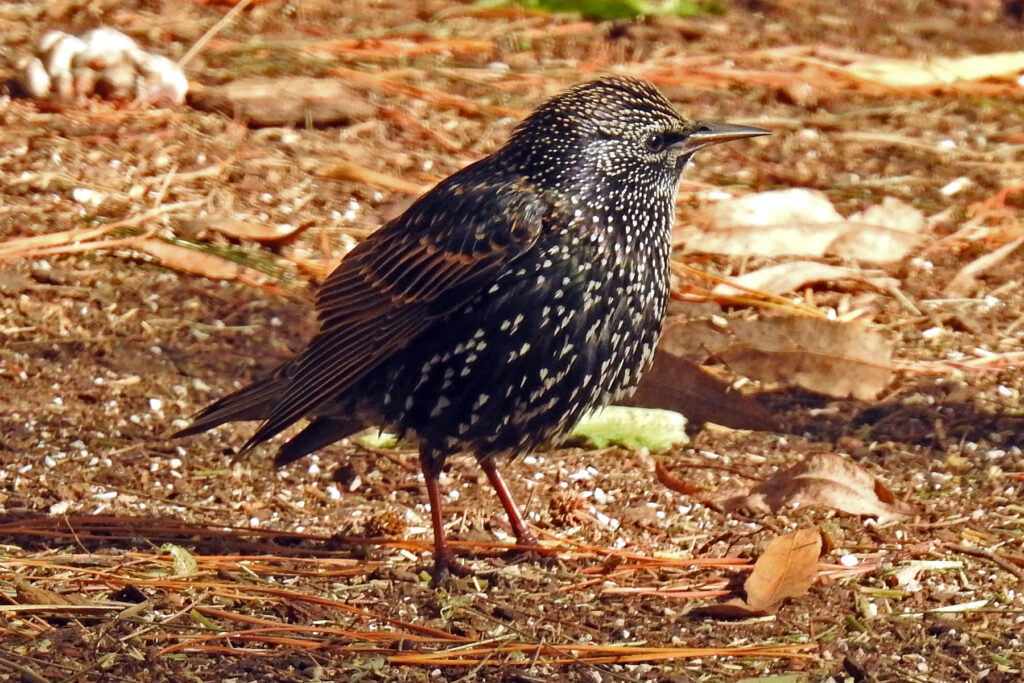Shrubs from community plantings support birds at Ginninderra
Over the last six years, CSIRO has been monitoring woodland bird numbers in areas that were revegetated during our community planting days in 2017-2018. The results are promising, with many small native birds and other sensitive species observed in the planted areas as the shrubs become more established.
Shrub planting to restore habitat
In their original condition, Box Gum Grassy Woodland and Derived Native Grasslands typically contained patches of shrubs covering around 5-10% of the area. However, as is typical throughout the entire range of the woodlands, the mid-storey shrub layer at Ginninderra had been lost historically through grazing and clearing.
Working with external environmental consultants, CSIRO ecologists helped identify areas of woodland and grasslands at Ginninderra that were of conservation concern and would benefit from shrub replanting. In 2017-2018, around 5000 shrubs were planted in these identified areas in partnership with the local community, the Ginninderra Catchment Group and the Indigenous Green Army.

A shrub planting event at Ginninderra. Shortly after planting, all plots were fenced off. The paddocks containing the plantings continued to be grazed as per normal farm operations but the plantings were and still are well protected.
The plantings were designed to create mid-storey patchy shrub ‘groves’ for smaller woodland birds. As well as providing high-quality foraging and nesting sites, the shrubs would be a sanctuary from larger birds and predators and enhance connectivity between habitats.
It was hoped that these biodiversity restoration efforts would potentially contribute to the increased resilience and persistence of existing bird populations at Ginninderra and, if successful, maintain or potentially increase bird diversity and abundance as more species utilise the enhanced complexity and habitat features.

A completed section of shrub replanting at Ginninderra in 2017

The same planting in July 2024
Monitoring the birds
The research team selected three locations at Ginninderra where plantings had taken place to monitor bird activity. Two control sites were also identified near to Ginninderra which had similar habitat and management history, and one control site within Ginninderra. These control sites had not undergone any shrub restoration, so they provided a useful comparison to monitor the effect of the plantings.
The team conducted bird survey sessions in autumn and spring, commencing in autumn 2017. During each survey session, at each site, a survey was conducted in the morning and afternoon on the same day, and then again in the morning of the following day. Twelve rounds of surveys were conducted across the six locations from autumn 2017 to autumn 2023, comprising 99 individual surveys at each site.
Abundance versus diversity
In analysing the recorded data, a distinction was made between bird abundance and bird diversity or richness. Abundance is the simple count of individuals of a single species observed, whereas diversity is a count of the number of species observed. This helps give a better impression of the effect of the plantings.
Abundance alone can be misleading, as the total figure can be largely made up of already common birds and those that form flocks. It is not a suitable indicator of biodiversity or species richness, particularly when considering more solitary species.
Bird findings for all species
A total of 90 bird species were recorded across the six locations.

It was hoped the shrub plantings would provide habitat for smaller birds such as the Grey Fantail (image by Trevor Rix, Canberra Nature Map)
Vulnerable species
It was promising to see several smaller vulnerable species at the planted sites, including the Scarlet Robin, White-winged Triller during the study.

The Scarlet Robin is listed as vulnerable in the ACT (image by Matthew Frawley from Canberra Nature Map)
There were 21 Scarlet Robin records across all sites during the monitoring period. Seven were from two of the three replanted Ginninderra locations and fourteen were observed across the three control sites. Scarlet Robins are altitudinal and seasonal migrants, moving to higher areas in spring and summer, consequently all Scarlet Robin records for this study came from autumn surveys. Nevertheless, it is encouraging to see that Scarlet Robins are not only recorded at the planted sites but have been observed foraging in the planted plots.
There were 39 White-winged Triller records across all sites, with 22 coming from control sites and 17 from two of the three planted sites. White-winged Trillers are also seasonal migrants, with all but one record from this study coming from spring surveys.
The Common Starling (Sturnus vulgaris), an introduced pest species, was however by far the most abundant species.
After Common Starlings, parrots in flocks (eg Crimson Rosellas Platycercus elegans and Sulphur-crested Cockatoos Cacatua galerita), generalist species such as Australian Magpies (Gymnorhina tibicen), Australian Ravens (Corvus coronoides) and large honeyeaters (eg Red Wattlebirds Anthochaera carunculata) were the most prevalent. These species are known to be well suited to degraded and fragmented landscapes and were expected to be common to all sites.

The Common Starling, an exotic bird, was by far the most abundant species – the starling pictured has its winter plumage (image by Deb Ralph from Canberra Nature Map)
Noisy Miner (Manorina melanocephala) numbers were low and not common to all locations. This is encouraging for restoration efforts as Noisy Miners are known to form large groups in degraded landscapes and harass and suppress the abundance and diversity of the smaller species the replanting was attempting to support. The Noisy Miner is the only native faunal species in Australia listed as a Key Threatening Process (Environment Protection and Biodiversity Conservation (EPBC), 1999) when over-abundant.
Although analysis has not yet detected a significant impact of the plantings on bird abundance or diversity during the survey period, there are a number of encouraging signs. The plantings are very healthy, with high survival rates of seedlings to mature shrubs. We have observed a wide variety of woodland bird species, including vulnerable and threatened species, many of which were observed in the plantings, rather than just at the wider site where plantings occurred. We have seen significant differences in abundance and diversity between seasons (autumn and spring), which is to be expected as migrants return to the site each spring. We have also seen significant differences in diversity and abundance within seasons, meaning for example there is a great deal of variability when comparing all the autumn surveys across years. We detected significant differences in abundance and diversity when comparing morning with afternoon survey results, with more birds and more species observed in morning surveys.
The high degree of variability in abundance and diversity results is not unusual for observational bird surveys and it is this variability which makes firm statistical conclusions difficult. Undertaking three surveys per survey session, as well as doing morning and afternoon surveys and ensuring surveys are done in favourable weather conditions, are all designed to overcome some of this inherent variability so that a reasonable ‘snapshot’ of bird data can be gained. Nevertheless, each site is still only visited for a total of 4 days per year. On top of this, the La Nina conditions experienced for many years throughout this study have likely meant conditions are more favourable across the landscape, including at control sites, meaning it is more difficult to detect a difference between planted and non-planted sites.
So, while there is no statistical evidence for a positive impact of plantings on bird abundance and diversity yet, we should not be discouraged. There is no doubt all birds, and particularly small birds of special conservation interest, are using the plantings, at least for shelter and foraging. It is our hope that as the plantings continue to mature, we will see a clearer impact emerge.
Smaller birds and sensitive species
A subset of 21 smaller and sensitive bird species were also identified that the research team were hoping would particularly benefit from the plantings at Ginninderra. The research team identified this list as ‘focal species’ and these will be analysed as a separate group as part of the overall analysis of all observations. The focal species were:
- Buff-rumped Thornbill (Acanthiza reguloides)
- Diamond Firetail (Stagonopleura guttata) cc
- Double-barred Finch (Taeniopygia bichenovii) cc
- Dusky Woodswallow (Artamus cyanopterus)
- Grey Fantail (Rhipidura albiscapa)
- Leaden Flycatcher (Myiagra rubecula) cc
- Mistletoebird (Dicaeum hirundinaceum)
- Red-browed Finch (Neochmia temporalis)
- Scarlet Robin (Petroica boodang) T, cc
- Southern White-face (Aphelocephala leucopsis) cc
- Speckled Warbler (Pyrrholaemus sagittatus)
- Spotted Pardalote (Pardalotus punctatus)
- Striated Pardalote (P. striatus)
- Superb Fairy-wren (Malurus cyaneus)
- Varied Sittella (Daphoenositta chrysoptera) T
- Weebill (Smicrornis brevirostris)
- White-plumed Honeyeater (Lichenostomus penicillatus) cc
- White-throated Gerygone (Gerygone olivacea)
- White-winged Triller (Lalage tricolor) T
- Willie Wagtail (Rhipidura leucophrys)
- Yellow-rumped Thornbill (A. chrysorrhoa)
CC = conservation concern, T = Threatened (Bounds et al. 2021)
The monitoring data showed that both the abundance and diversity of these species increased slightly over time at all locations, but only during the autumn recording sessions.
Next steps
The research team will continue to conduct surveys to monitor bird numbers at the three replanted Ginninderra locations and the three control sites with final surveys due in spring 2026. This will help identify if there are any improvements in bird diversity and abundance as the replanting areas become more established.
The research data will be used to inform our ongoing site management and future environmental planning for Ginninderra. Plans are in place to arrange a data-sharing agreement with the ACT Government so that findings from this project can be shared more broadly in the ACT. The research team is also planning to present the findings for publication in a scientific journal upon project completion.
References
Bounds J., Davey C., Taws N., Evans M. J., Rayner L. (2021). Long-term Trends in ACT Woodland Birds 1998 – 2019. Canberra Ornithologists Group. Canberra, ACT.
Environment Protection and Biodiversity Conservation Act (1999) Department of Climate Change, Energy, the Environment and Water.
